ASTANA, Kazakhstan -- According to Korean Ambassador to Kazakhstan Kim Dae-sik, the fact that Korea has the largest pavilion at the Astana International Exposition site is no coincidence.
“The sheer size of the Korean pavilion at 1,800 square meters demonstrates the close friendship and trust between our two countries,” he told The Korea Herald in an exclusive interview at the venue on June 9.
The expo, designed to spotlight Kazakhstan’s vision and plans for future energy and sustainable development, began on June 10 and runs through Sept. 10 on the outskirts of Astana, the newly built, sleek Kazakh capital. The event aims to illuminate Kazakhstan’s transition to renewables, as it plans to derive half of its energy from green sources by 2050, the year it targets for entering the ranks of the world’s 30 richest economies. Some 115 countries and 22 international organizations have participated in the event.
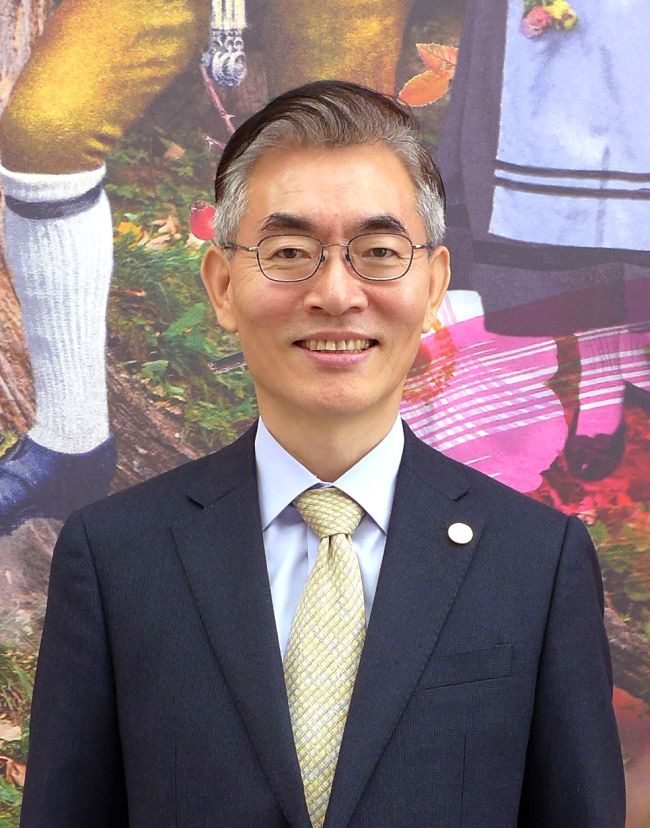 |
Korean Ambassador to Kazakhstan Kim Dae-sik (Joel Lee/The Korea Herald) |
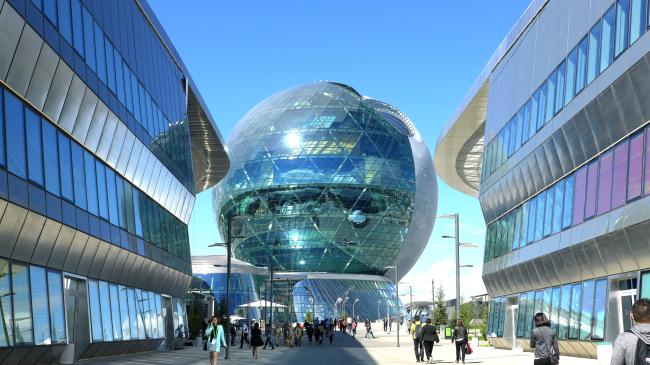 |
The glistening “Nur Alem” Kazakh pavilion in the center of the Astana International Exposition site, the largest of its kind in the world, was built to showcase Kazakhstan’s vision and plans for sustainable energy. (Joel Lee/The Korea Herald) |
The Korean pavilion -- under the theme “future energy, smart life” -- offers a glimpse of the country’s future energy combining renewable sources and information and communications technology solutions. Visitors learn about Korea’s 10 key energies and related technologies -- wind, solar, energy-independence, smart energy building, home Internet of Things, intelligent microgrid, batteries, energy storage, smart home heating and fuel-cell cars -- on a tablet PC wirelessly linked to incandescent poles.
The second floor of the pavilion is dedicated to Korean culture, putting on display TV dramas, films, celebrities, food and travel destinations, as well as promoting the PyeongChang 2018 Winter Olympics. Some 250 Korea-related performances and events are scheduled throughout the three-month period, culminating in “Korea Day” on July 19, which will feature K-pop concerts and a bilateral energy forum, among other events.
“As a newly created independent state in 1991, Kazakhstan has greatly valued Korea’s rapid national and economic development,” Kim underscored. “Kazakhstani President Nursultan Nazarbayev pays special attention to Korea and the whole of Kazakhstan watches Korea with keen interests.”
Korea over the years has also opened its eyes to the rising Central Asian powerhouse, he noted, mentioning the two countries’ heads of state have met frequently through summits and multilateral forums. Seoul and Astana established diplomatic relations in 1992, and this year marks the silver jubilee of bilateral relations.
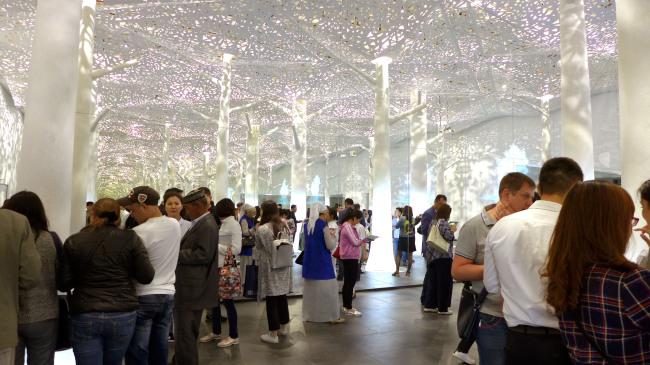 |
The Korean pavilion -- under the theme “future energy, smart life” -- offers a glimpse of the country’s future energy combining renewable sources and information and communications technology solutions. (Joel Lee/The Korea Herald) |
 |
The centerpiece of the Korean pavilion is a show that seamlessly fuses a graphic movie and dazzling dance by Kazakh artists on stage, where Kazakh boy “Astan” learns the value of green energies through Korean girl “Ara” on a journey leading to eco-friendly Jeju Island in Korea. (Joel Lee/The Korea Herald) |
Highlighting the popularity of Korea in Kazakhstan -- centered on its development legacy, advanced technologies, pop music, film and food, fashion, beauty and other products -- the envoy said Kazakhstani leaders and citizens are eager to develop a friendship and learn from Korea’s experiences. The success and dedication of some 100,000 ethnic Koreans in Kazakhstan, known in Korea as “Koryo-saram” or “Koryo-in,” have also added to the country’s positive image, he expounded.
“Kazakhstan is a country briskly moving ahead with clearheaded plans and strategies under the leadership of President Nazarbayev,” the ambassador argued, citing the president’s foresighted decision to move the capital to Astana in 1997 against opposition.
A modern, planned city in the vein of Brazil’s Brasilia and Australia’s Canberra, Astana was designed by Japanese architect Kisho Kurokawa as an efficient metropolis filled with futuristic buildings and modern amenities. Astana is also the seat of the government, parliament, Supreme Court, presidential palace and numerous other state departments and agencies.
The Nazarbayev University in Astana, founded in 2010, is another example of Kazakhstan’s future-oriented preparation, according to the diplomat. “The university is an ambitious national project to nurture the next generations of Kazakhstan’s leaders, with all courses taught in lingua franca English by prominent scholars and faculty staff from around the world,” Kim underlined.
 |
Standing 100 meters from the ground with an 80-meter diameter, the Nur Alem Kazakh pavilion illuminates the Central Asian country’s future energies -- water, kinetic, biomass, wind, solar and space -- as well as culture and history, in a myriad of models resembling scenes from science-fiction. (Joel Lee/The Korea Herald) |
 |
Standing 100 meters from the ground with an 80-meter diameter, the Nur Alem Kazakh pavilion illuminates the Central Asian country’s future energies -- water, kinetic, biomass, wind, solar and space -- as well as culture and history, in a myriad of models resembling scenes from science-fiction. (Joel Lee/The Korea Herald) |
The government gives scholarships to the best and the brightest students, who graduate with a mindset geared toward the world. “Equipped with a global perspective, they will go on to play key roles in the country’s top positions. Kazakhstan’s future looks bright if it can harness its talented human resources with endowed natural resources.”
The envoy advised young Korean job seekers and entrepreneurs to consider Kazakhstan and the larger Central Asia. He pointed to opportunities in the education sector, where Korea’s brand image, culture and technology are much sought after. The Korean Cultural Center in Astana and Korean Education Center in Almaty offer various cultural and language programs, and thousands of students annually enroll in them and graduate.
Turning to Seoul’s Eurasian diplomacy, Kim explicated Astana’s decision to relinquish its nuclear weapons on Aug. 29, 1991, by terminating the Semipalatinsk nuclear test site, a primary experiment ground for the Soviet Union’s atomic arsenal.
“Having forgone its military nuclear capacity voluntarily, Kazakhstan has an unshakable conviction on the North Korean nuclear and missile issue,” he elucidated, referring to Astana’s vision of a world free of nuclear weapons.
 |
The expo, which began June 10 and runs through Sept. 10, aims to spotlight Kazakhstan’s sustainable transition to renewables, with plans to derive half of the country’s power from green sources by 2050, the year it aims to enter the ranks of the world’s 30 richest economies. (Joel Lee/The Korea Herald) |
 |
Visitors participate in an interactive activity at the Nur Alem Kazakh pavilion. Although blessed with oil, natural gas, coal, uranium and other mineral resources, Kazakhstan has used its ideal topological conditions to harness wind and construct small hydro and solar projects, building on the large hydro and geothermal sources from the Soviet era. (Joel Lee/The Korea Herald) |
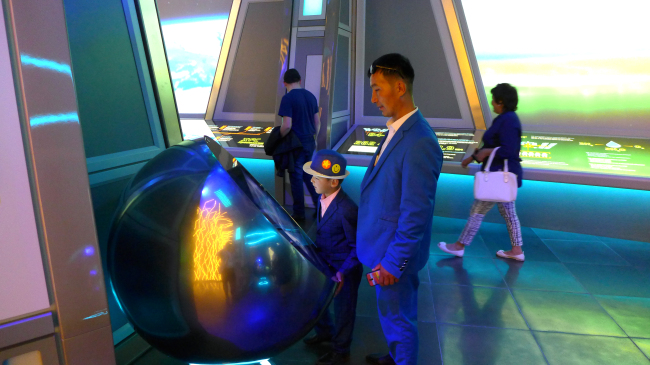 |
Visitors participate in an interactive activity at the Nur Alem Kazakh pavilion. Although blessed with oil, natural gas, coal, uranium and other mineral resources, Kazakhstan has used its ideal topological conditions to harness wind and construct small hydro and solar projects, building on the large hydro and geothermal sources from the Soviet era. (Joel Lee/The Korea Herald) |
During the Shanghai Cooperation Organization summit in mid-June, President Nazarbayev reiterated the call for denuclearizing the Korean Peninsula through dialogue, stressing the gravity of the issue. The Kazakh Foreign Ministry has similarly issued statements condemning North Korea’s missile launches since the start of Moon Jae-in’s administration.
With the launch of China’s “One Belt, One Road” global infrastructure and development initiative, which passes through Kazakhstan, the country’s economy is poised to take off, the diplomat said.
“Kazakhstan is trying to become Eurasia’s hub of transport, logistics and finance, and once proper infrastructures are set in place, any inefficiencies and barriers along the intercontinental railways and roads will taper off. Trade will be greatly facilitated and streamlined along the ancient Silk Road routes.”
By Joel Lee, Korea Herald Correspondent (
joel@heraldcorp.com)
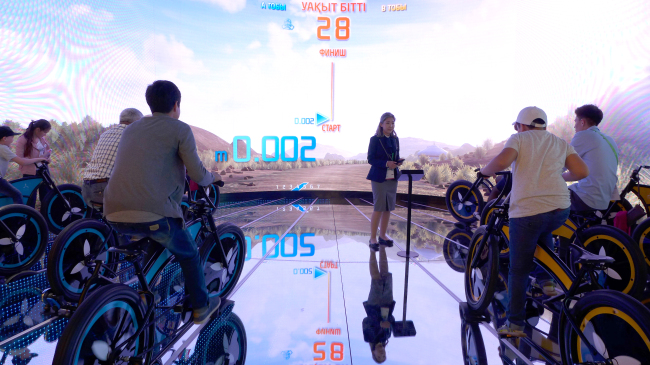 |
Visitors participate in an interactive activity at the Nur Alem Kazakh pavilion. Although blessed with oil, natural gas, coal, uranium and other mineral resources, Kazakhstan has used its ideal topological conditions to harness wind and construct small hydro and solar projects, building on the large hydro and geothermal sources from the Soviet era. (Joel Lee/The Korea Herald) |
 |
Over 100 countries have participated in the expo with national pavilions, alongside numerous companies and 22 international organizations, including the UN Economic and Social Commission for Asia and the Pacific, Shanghai Cooperation Organization and International Atomic Energy Agency. (Joel Lee/The Korea Herald) |


















